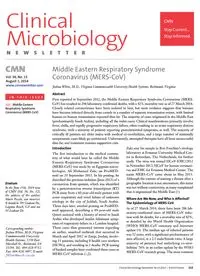
2014 Middle Eastern Respiratory Syndrome Coronavirus (MERS-CoV) PDF
Preview 2014 Middle Eastern Respiratory Syndrome Coronavirus (MERS-CoV)
Clinical Microbiology Newsletter 36:15,2014 | ©2014 Elsevier 115 Introduction The first introduction to the medical commu- nity of what would later be called the Middle Eastern Respiratory Syndrome Coronavirus (MERS-CoV) was made by an Egyptian micro- biologist, Ali Mohamed Zaki, on ProMED- mail on 20 September 2012. In his posting, he described the previous isolation (June 2012) of a coronavirus from sputum, which was identified by a pancoronavirus reverse transcriptase (RT) PCR assay from a 60-year-old male patient with acute respiratory and renal failure of unknown etiology in the city of Jeddah, Saudi Arabia. Three days later, another posting on ProMED- mail appeared, describing a 49-year-old male Qatari national with a history of travel to Saudi Arabia who developed similar fulminant symp- toms of respiratory failure in a London hospital. These cases then generated interest regarding an earlier, unsolved outbreak that occurred in March and April 2012 in Zarqa, Jordan, involv- ing 11 patients, including 8 health care workers (HCWs), and resulting in 2 deaths. PCR testing of banked samples later confirmed these cases as MERS-CoV infection (1,2). Zaki sent his sample to Ron Fouchier’s virology laboratory at Erasmus University Medical Cen- ter in Rotterdam, The Netherlands, for further study. The virus was named HCoV-EMC/2012 in November 2012; HCoV for human coronavi- rus and EMC for Erasmus Medical Center. The name MERS-CoV came about in May 2013. Although the custom of naming a disease after a geographic location is not uncommon, this name was not without controversy, as many complained that it stigmatized the Middle East (3). Where Are We Now, and Who is Affected? The Epidemiology of MERS-CoV As of 27 March 2014, there have been 206 lab- oratory-confirmed cases of MERS-CoV infec- tion with 86 deaths, for a mortality rate of 42%, as detailed by the World Health Organization (WHO) MERS-CoV summary and literature update (4). The median age of infected patients was 52 years, with a significant predominance of men affected, at a 2:1 male/female ratio. A large majority of patients had underlying co-mor- bidities: 76% in an earlier update by the WHO MERS-CoV research group. The most common Vol. 36, No. 15 August 1, 2014 www.cmnewsletter.com I N T H I S I S S U E 115 Middle Eastern Respiratory Syndrome Coronavirus (MERS-CoV) Corresponding author: Joshua White, M.D.,Virginia Commonwealth University Health Systems, 1250 East Marshall St., Richmond, VA 23298. Tel.: 804-828-9712. Fax: 804-828-3097. E-mail:
